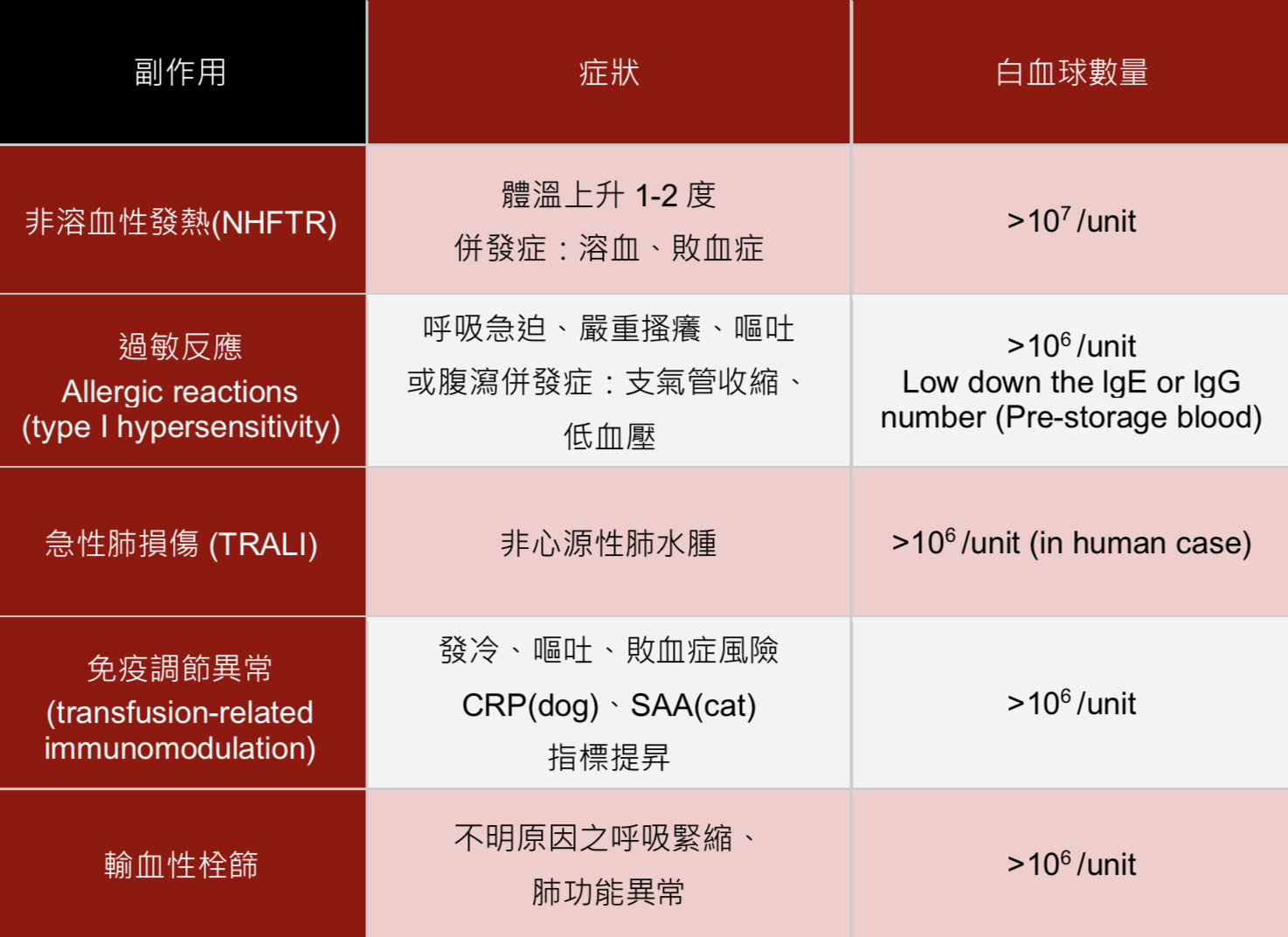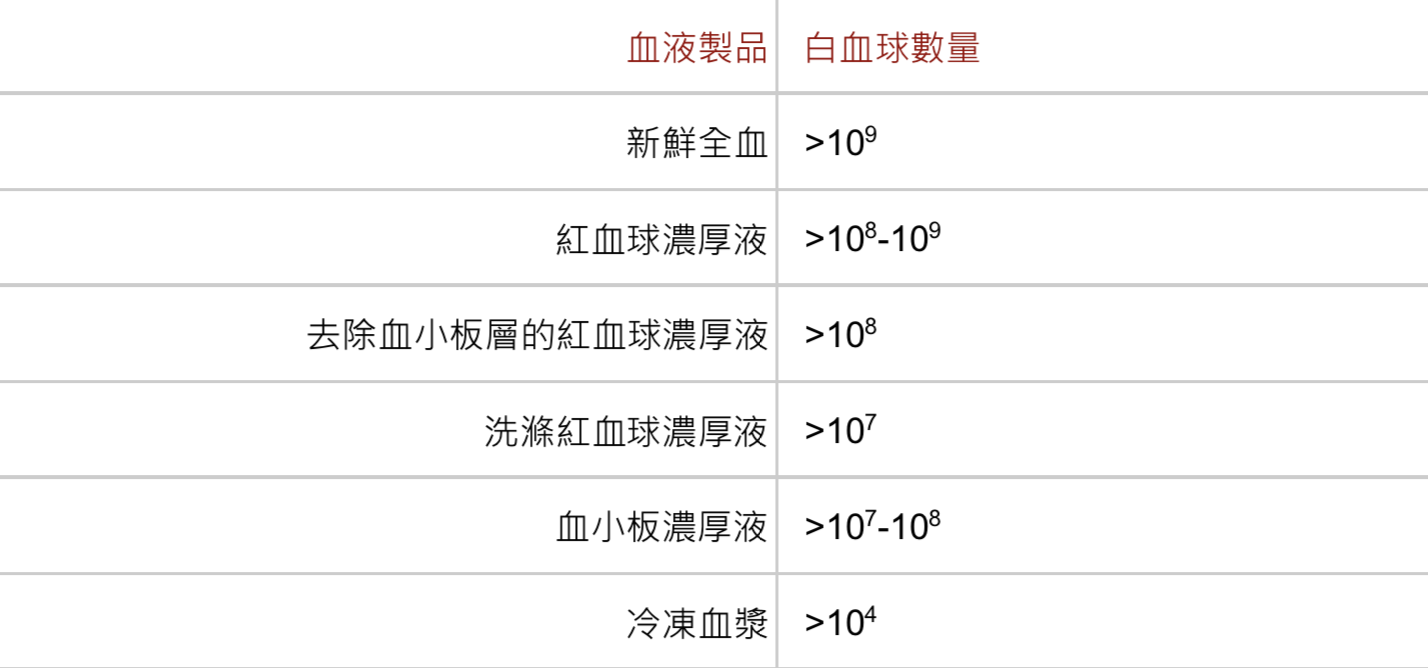Questions&Supports
1. Why leukoreduction is needed when transfusion?
Just like human, blood type crossmatch can greatly increase and ensure the compatibility of blood between donor and recipient canine or feline. However, when blood transfusion is execution, donor white blood cell will be transfused to the recipient and maybe induce a series of immune responses such as fever, vomiting and purpura.
In addition to the immune response of blood recipients during blood transfusion, small animal transfusion therapy also includes other risks such as parasites, infections, etc.
In human blood transfusion medicine, remove white blood cell has become a norm. Studies also proved that the donor white blood cells are a non-functional blood pollutant for most blood recipients.
Studies have proved that the number of leukocytes is in association with the syndrome of transfusion reactions.
Most of the side effects are found when leukocytes are more than 10^6 in one unit.
Please find below for more details:

All blood products contain white blood cells, and the number of white blood cells varies according to the type of blood products.

A medical retrospective review indicated that,
- Approximately 15% had occurred adverse reaction, of the 935 blood transfusion records recorded for 558 dogs,
- About 6.3% of transfusion reactions occurred on 246 feline transfusion records recorded for 133 cats.
In the above transfusion reactions, the most common transfusion reaction is fever, followed by vomiting, and even a small number of cases of shock death. In order to reduce the risk of blood transfusion, antihistamines are often used to reduce the risk of allergies. However, other complications caused by drugs and subsequent transfusion reactions also produce corresponding care and costs.
The study also pointed out that the transfusion reaction has nothing to do with the age, sex or drug administration before the blood transfusion, and is related to the blood species. Therefore, some veterinary blood banks have used a leukoreduction filter to reduce the occurrence of FNHTRs.
5. Bruce, et. al., Effect of premedication and other factors on the occurrence of acute transfusion reactions in dogs. J. Vet. Emerg. Crit. Care. 2015, 25(5): 620-630.
2.已證實的白血球過濾臨床效益
• 防止或降低急性、延遲性輸血引起之免疫反應
• 降低輸血後引起之CRP(犬)、SAA(貓)指標提升,引起多重器官損傷並發症
• 防止輸血引起之非溶血性發熱
• 防止血液製品微聚體引起之立即或遲發性輸血性栓篩 (Embolism)
• 防止心絲蟲幼蟲透過血液傳播
研究中發現,觀察狗輸注去除白血球血液與未去除白血球的血液,輸注後觀察0天至24天,白血球去除的血品其分段嗜中性粒細胞增生的情況較低,且體內C反應蛋白(炎症因子)的含量明顯降低,如圖三所示,代表輸注去除白血球的血液,可有效降低動物輸血的發炎反應,且輸血前移除血液中的白血球,可維持輸血血液中紅血球的攜氧能力,並可減少因儲存所造成的血液病變。

而近期的研究顯示,當患有癌症或腫瘤的病患輸血時,會因輸血血液中因白血球所引發的大量生長因子(VEGF),不利於抑制腫瘤,另一方面,使用去除白血球的血液,則可有效降低輸血血液中的VEGF,減少對於腫瘤患者的影響,對於施行腫瘤手術的動物來說,會有助於手術後控制腫瘤的復發。
3.可以用人類醫療用減白濾器過濾嗎? 珍貴熱血別白費!
目前市面上還沒有小動物專用過濾器時,部分獸醫會選擇使用人類專用的白血球過濾器,白血球的去除效率上雖可符合預期,但過濾器的血液耗損量高達 40-50 mL!以現行動物血庫捐血標準,狗狗單次最多捐 250 mL、貓咪單次捐血約 50 mL,如果使用人類用減白過濾器,等於將近五分之一的血液白白被浪費掉。更重要的是,目前國內動物尚未普及建置血庫,大多數血液的捐贈來源還是來自於飼主間的互相幫忙,每一滴血液都得來不易,非常珍貴,如果仍繼續使用人類用的減白過濾器,將會浪費掉許多珍貴的血液。
使用PuriVet®專為小動物設計的減白過濾器,每250 mL 最多僅耗損 20 mL,擁有最好的白血球去除率及血液回收效率,讓每滴寶貴的血液,真正流入毛寶貝的身體裡。
1.輸血治療 – 為什麼小動物輸血需要減白?
通常毛寶貝患有嚴重貧血、執行會大量失血的手術、因血液寄生蟲感染造成急性缺血等,當HCT小於10%時,醫師會建議需要緊急輸血治療。但您知道在輸血治療過程中,因血液裡的白血球所引發的併發症,嚴重可能致命嗎?
國外研究指出約有15%的狗貓在接受輸血過程中或輸完血後有不良反應,如發燒、嘔吐、皮膚過敏等。
這是因為捐血者血液裡面的白血球,引發接受血液的狗狗體內產生免疫反應。其實在國外研究裡面,已經證實捐血血液內的白血球是一種不具功能性的血液汙染物1。甚至白血球數量多寡與觸發不良反應有所關聯(請見下表)2、3,有少部分狗狗更因輸血導致休克死亡。

輸血前,獸醫們會進行嚴格的血液配對以及篩檢程序,再進行血液捐、輸血。以犬來說,現在共分為7種以上血型,輸血前主要檢查是否為DAE1.1,如不是這個血型可以輸一次血,但實際上可能是另外六種互不相容的血型,只是輸血反應較輕微。至於貓咪,雖只有2-3種血型,但貓咪對外來血球的免疫反應通常較為激烈,因此必須謹慎配對。
部分獸醫會在輸血前增加使用抗組織胺藥物以緩和發炎症狀。然而,研究指出投藥也可能會引發其他併發症,並且延緩排斥反應、延長照護時間,增加飼主醫療負擔。同時,國外研究也指出,輸血反應與是否有投藥較無關係,反倒是與血品內白血球含量及儲放方式較有關聯。如果使用去除白血球的血品,將可以大幅降低不良輸血反應風險。
2.可以用人類醫療用減白濾器過濾嗎? 珍貴熱血別白費!
目前市面上還沒有小動物專用過濾器時,部分獸醫會選擇使用人類專用的白血球過濾器,白血球的去除效率上雖可符合預期,但過濾器的血液耗損量高達 40-50 mL!以現行動物血庫捐血標準,狗狗單次最多捐 250 mL、貓咪單次捐血約 50 mL,如果使用人類用減白過濾器,等於將近五分之一的血液白白被浪費掉。更重要的是,目前國內動物尚未普及建置血庫,大多數血液的捐贈來源還是來自於飼主間的互相幫忙,每一滴血液都得來不易,非常珍貴,如果仍繼續使用人類用的減白過濾器,將會浪費掉許多珍貴的血液。
使用PuriVet®專為小動物設計的減白過濾器,每250 mL 最多僅耗損 20 mL,擁有最好的白血球去除率及血液回收效率,讓每滴寶貴的血液,真正流入毛寶貝的身體裡。
